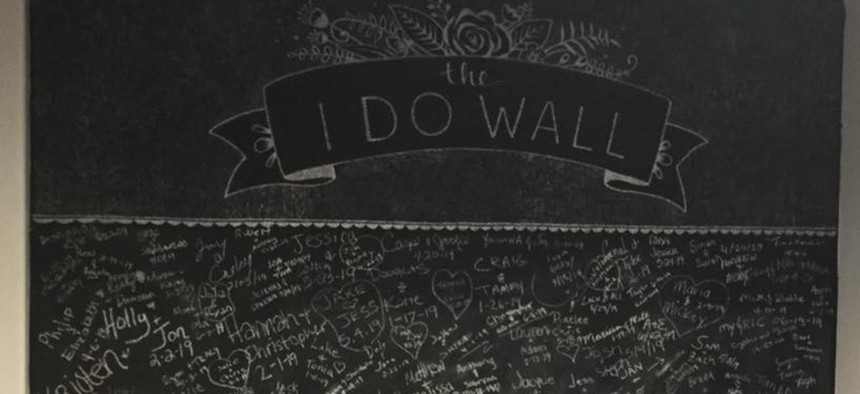‘I Do Wall’ Seeks to Change Perceptions of Local Government

An 'I Do Wall' makes the process of applying for a marriage license less taxing. Courtesy of Washington County, Wisconsin
The clerk of Washington County, Wisconsin, wanted to do something special for couples applying for marriage licenses.
When Ashley Reichert took office in January 2017, she knew she wanted to bring something new to the county clerk position in Washington County, Wisconsin. In a brainstorming session with her team, they hit upon the idea of trying to make the process of applying for a marriage license more exciting. Reichert had a chalk wall at home, so she suggested something simple, but sweet: an ‘I Do Wall’ for couples to sign and pose for a photo in front of, symbolizing the start of their union.
“Government gets a bad rap for being boring and status quo,” she said. “So we wanted to create something different that we hadn’t seen before. Something that would add fun to a process that otherwise would be formal and not as exciting as your wedding.”
Congratulations to all of our couples that have or are getting married yet this year! My team and I are so honored to be able to assist so many wonderful couples with their marriage licenses. Thank you for signing our #IDoWall pic.twitter.com/gZbEmhBRoY
— Ashley Reichert (@ashreichert27) June 22, 2019
The wall, which stands behind the two stations where couples can apply for their licenses, held outdated maps before Reichert asked the facilities team to cover it in chalk paint. Reichert estimated that over 1,000 couples have chalked their names on the wall since it was painted in summer of 2017. The wall currently only has around 300 signatures, though, as it had to be erased recently when there was no more space left.
Reichert said the real joy is seeing how people choose to represent themselves. Some couples sign their names along with a wedding date, while others draw pictures of themselves and use different fonts. Because the county clerk’s office staff now spends more time with couples while they apply for licenses, they also get to hear stories about how the couples met and where they live.
“It’s always funny when you find out you’re probably related to someone, or they live near you,” she said. “And there’s couples who have been married, got divorced and are getting remarried 20 years later.” Reichert said her favorites are the couples who reconnect decades after graduating high school.
In its storytelling capacity, the wall has also become a sort of community message board on the Washington County Facebook page, as office staff post the photos they take of couples in front of the wall. Strangers and friends alike congratulate signers on their nuptials. “It’s so beautiful when people share their congratulations with the couples. It’s really building a sense of community,” Reichert said.

Now, couples will come in for licenses and already know about the wall, Reichert said. The county’s social media presence has also helped the clerk’s office get the word out about what documents are required for a marriage license. Before the wall’s popularity, Reichert said couples often forgot birth certificates, or didn’t know about Wisconsin’s six-day waiting period to get the license.
Most importantly, Reichert said that the wall gives a “face to government” and helps people understand that “interacting with government doesn’t have to be a chore.” Now, the county clerk—an otherwise obscure office that handles a range of responsibilities, from setting up election polling sites to issuing various licenses—is more transparent, accessible, and human.
“Engaging with the public we serve, both in the office and on social media, is a really powerful tool,” Reichert said. “It’s my favorite part of the job.”
Emma Coleman is the assistant editor for Route Fifty.

NEXT STORY: Building smart cities starts with safety and mobility






